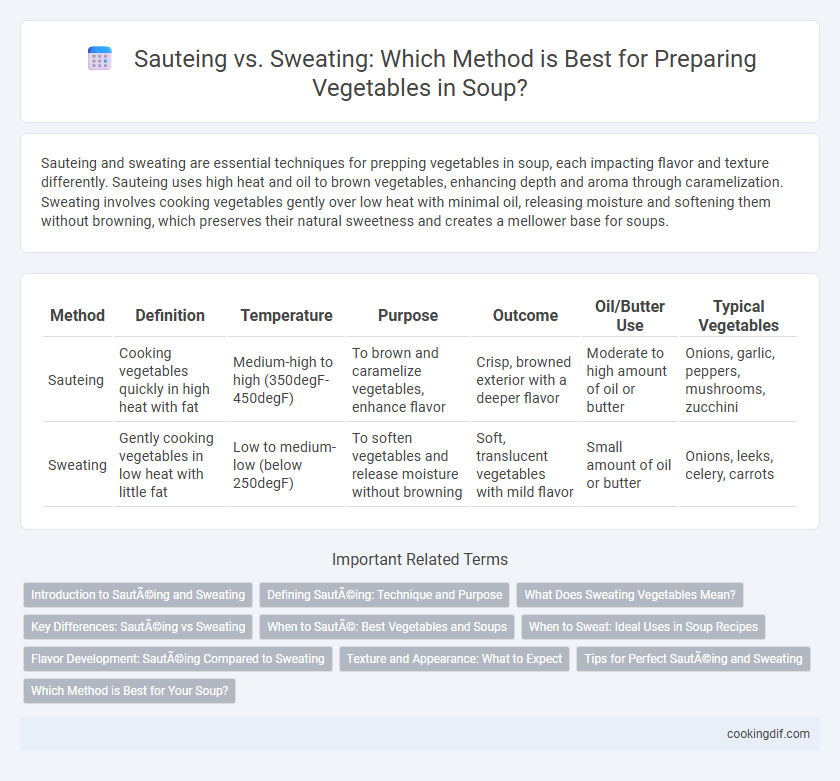Sauteing and sweating are essential techniques for prepping vegetables in soup, each impacting flavor and texture differently. Sauteing uses high heat and oil to brown vegetables, enhancing depth and aroma through caramelization. Sweating involves cooking vegetables gently over low heat with minimal oil, releasing moisture and softening them without browning, which preserves their natural sweetness and creates a mellower base for soups.
Table of Comparison
| Method | Definition | Temperature | Purpose | Outcome | Oil/Butter Use | Typical Vegetables |
|---|---|---|---|---|---|---|
| Sauteing | Cooking vegetables quickly in high heat with fat | Medium-high to high (350degF-450degF) | To brown and caramelize vegetables, enhance flavor | Crisp, browned exterior with a deeper flavor | Moderate to high amount of oil or butter | Onions, garlic, peppers, mushrooms, zucchini |
| Sweating | Gently cooking vegetables in low heat with little fat | Low to medium-low (below 250degF) | To soften vegetables and release moisture without browning | Soft, translucent vegetables with mild flavor | Small amount of oil or butter | Onions, leeks, celery, carrots |
Introduction to Sautéing and Sweating
Sauteing vegetables involves cooking them quickly in a small amount of oil or fat over medium-high heat, which enhances flavor through browning and caramelization. Sweating is a gentler cooking method using low heat and minimal fat to soften vegetables, releasing their natural moisture without browning. Both techniques are essential for building depth and complexity in soup bases by controlling texture and flavor development.
Defining Sautéing: Technique and Purpose
Sauteing involves cooking vegetables quickly in a small amount of fat over medium-high heat to develop a browned, caramelized exterior that enhances flavor and texture. This technique uses constant stirring or tossing to ensure even cooking and prevent burning. The purpose of sauteing is to add depth and richness to soups by concentrating the natural sugars and creating complex flavors through the Maillard reaction.
What Does Sweating Vegetables Mean?
Sweating vegetables involves cooking them gently over low heat with a small amount of fat, often covered, to soften and release their moisture without browning. This technique preserves the natural sweetness and enhances the flavors in soups by allowing the vegetables to tenderize and blend seamlessly. Unlike sauteing, sweating emphasizes moisture release and subtle flavor development rather than caramelization.
Key Differences: Sautéing vs Sweating
Sauteing vegetables involves cooking them quickly over high heat with a small amount of fat, resulting in caramelization and enhanced flavor through browning. Sweating, on the other hand, cooks vegetables gently over low heat with minimal or no browning, typically in a covered pan to release moisture and soften without color change. These techniques differ mainly in temperature, cooking time, and desired outcome, with sauteing intensifying taste and sweating preserving subtle vegetable flavors for soups.
When to Sauté: Best Vegetables and Soups
Sauteing is ideal for hearty vegetables like onions, carrots, and celery that benefit from caramelization to enhance the soup's depth of flavor. It works best in robust soups such as French onion, minestrone, or vegetable beef, where browning the vegetables adds complexity and richness. Use sauteing when aiming for a deep, savory base rather than a delicate, sweet flavor profile.
When to Sweat: Ideal Uses in Soup Recipes
Sweating vegetables is ideal for soups requiring a delicate base flavor, as it gently softens ingredients like onions, celery, and carrots without browning, preserving their natural sweetness. This technique is especially effective for clear broths and light vegetable soups where clarity and subtlety of taste are paramount. Use sweating when the goal is to release moisture and aroma, creating a balanced foundation that enhances the soup's overall flavor profile without adding caramelized notes.
Flavor Development: Sautéing Compared to Sweating
Sauteing vegetables in oil or butter over medium-high heat caramelizes their natural sugars, intensifying flavor and adding depth to soups. Sweating, performed over low heat with minimal fat, softens vegetables without browning, preserving their delicate, subtle taste. Choosing sauteing enhances richness and complexity, while sweating maintains a lighter, fresher vegetable profile in soup preparation.
Texture and Appearance: What to Expect
Sauteing vegetables in soup preparation creates a caramelized, golden-brown exterior, enhancing texture with a slight crispness and rich flavor. Sweating, on the other hand, softens vegetables gently without browning, preserving a tender texture and vibrant color that blends smoothly into the soup base. Choosing between these methods affects the soup's overall appearance and mouthfeel, making sauteing ideal for depth and sweating preferable for subtle sweetness and uniform softness.
Tips for Perfect Sautéing and Sweating
Sauteing vegetables requires high heat and a small amount of fat to achieve a caramelized exterior and intense flavor, while sweating uses low heat with a lid and minimal fat to soften vegetables and release their natural moisture without browning. For perfect sauteing, ensure the pan is hot before adding vegetables, avoid overcrowding to maintain heat, and stir frequently for even cooking. When sweating, cook vegetables slowly over low heat, cover the pan to trap steam, and season lightly to enhance their sweetness and tenderness.
Which Method is Best for Your Soup?
Sauteing vegetables involves cooking them in oil or butter over medium-high heat to develop deeper flavors and a caramelized texture, ideal for hearty soups like minestrone or stew. Sweating uses low heat with minimal fat to soften vegetables without browning, preserving delicate flavors perfect for clear broths or light, vegetable-based soups. Choosing the best method depends on your soup's flavor profile and desired texture, with sauteing enhancing richness and sweating maintaining subtle freshness.
Sautéing vs Sweating for vegetable prep Infographic

 cookingdif.com
cookingdif.com